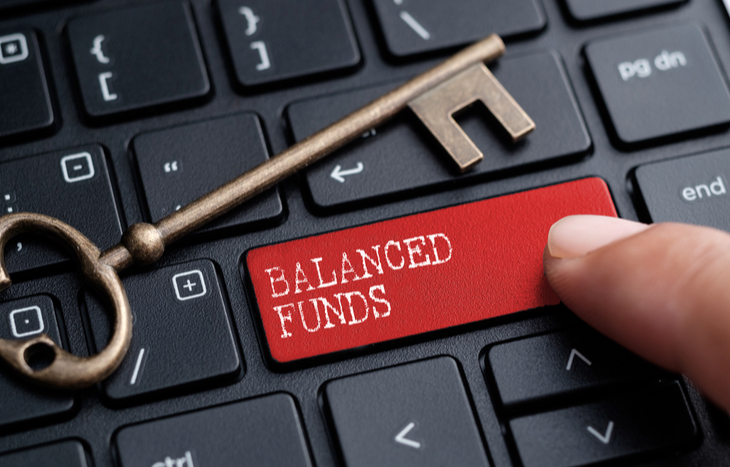What is a Balanced Fund?
Choosing the right investment strategy is about finding balance: usually, the balance between risk and reward. No matter what you invest in, these two factors always swing in tandem with one another. The more risk you burden on average, the greater the reward and vice versa. For many investors, there’s a happy medium right in the middle. It usually takes the form of a balanced fund.
These funds exist at the intersection of risk and reward. They offer equal parts of both, usually catering to investors who want a hands-off solution to investing. And these funds are often market-beating and offer some variability in terms of portfolio composition. Yet, they’re unlikely to generate explosive growth like more aggressive portfolios might.
Let’s take a closer look at balanced funds: how they work, what defines them and what to expect if you invest in one.

Balanced Fund Explained
Balanced funds have this title because, unlike more aggressive portfolios, they have both equity and bond components. Typically, this type of fund will hold about 50% to 70% of its assets in stocks and the remaining 30% to 50% in bonds. The heavier this ratio skews in favor of investment grade bonds, the more conservative the portfolio is.
These funds thrive because they have both growth potential and risk mitigation safeguards. Both sides of the equation are important. Here’s how they work together:
The Equity Component
Stock investments in a balanced fund serve two important functions. First, they preserve the purchasing power of the portfolio. That is to say, they grow at a more rapid pace than inflation. Second, stocks power the accumulation potential of the portfolio, to grow the vested balance at a targeted rate.
The Bond Component
The bond allocation within a balanced portfolio also serves two purposes. First, it generates income through the coupon payments from AAA corporate bonds. Second, to safeguard the portfolio against volatility that might impact equity focused portfolios to a more significant degree.
It’s important to note that while all balanced funds will include equity and bond components, there’s broad variability in how both allocations look. For example, an aggressive fund may have 70% equities invested in emerging markets, backed by 30% high-coupon callable bonds. Meanwhile, a conservative fund may focus on Dividend Aristocrat holdings and treasuries in a 50/50 allocation.
Target Date Funds
What’s the difference between balanced funds and target date funds? The answer is not a lot. Target date funds are a type of balanced fund, with portfolios specifically designed to generate growth over a predetermined time period. These funds then rebalance every few years to become more and more conservative the closer they get to the target date.
The Benefits
Balanced funds are extremely easy for many people to invest in because there’s very little downside in a strictly balanced approach. Here’s a look at some of the reasons these funds are among the most common investment vehicles for passive investors:
- There’s very little trading action within funds, which keeps them predictable
- Hands-off management means low-to-no expense ratio
- Diversification mitigates risk, while optimizing wealth accumulation
- Balanced funds allow investors to withdraw, without upselling asset allocation
- Historically safe performance even in bear markets and during corrections
- Wide spread across sectors and securities mitigates volatility
In short, balanced funds make it easy for those with little-to-no investing experience to feel good about putting their money into a single investment vehicle. As a result, these funds tend to attract everyone from new investors to those investing through retirement accounts.
The Drawbacks
Despite their ability to intrinsically balance risk and reward, there are still some drawbacks to balanced funds. Here’s a look at why balanced funds aren’t right for everyone, and where they can fall short in comparison to other investments:
- Fixed allocations mean that the fund won’t rebalance to capitalize on market forces
- These funds tend to generate a healthy amount of income, which is taxable
- Most balanced funds tie themselves to large companies that simply mirror major indices
- While the returns of a balanced fund are safe, they’re often limited by risk aversion
The key takeaway about these funds is that they’re not well-suited for exponential accumulation. Instead, they’re typically best for set-it-and-forget-it investors and those later into their investing time horizon. Younger investors can afford to be more aggressive.
Balanced Fund Examples
Interested in looking at a few of these funds, to see what you can expect from one? There are a broad number of high-performing funds out there, including these popular favorites:
- Vanguard Balanced Index Fund Admiral Shares (VBIAX)
- Fidelity Balanced Fund (FBALX)
- Schwab Balanced Fund (SWOBX)
- T. Rowe Price Personal Strategies Income (PRSIX)
- John Hancock Balanced Fund (SVBIX)
Again, there are a broad range of balanced products out there, each slightly different than the last. As you seek to balance risk and reward, explore funds that skew more aggressive or conservative within the confines of a 50/50 or 70/30 allocation.
Risk Control is the Name of the Game
Ultimately, balanced funds play on an investor’s desire to mitigate risk. While more aggressive investors will chase high returns with growth funds, balanced investors choose to safeguard themselves against volatility for a more predictable return.
If you’re the type of investor who wants to play it safe, a balanced allocation is the way to go. Your risk and returns will stick closer to the median, which will likely provide you with better peace of mind. And there are lots of great opportunities to diversify…





